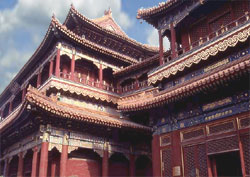Lama Temple
 Why the Lama Temple is special
Why the Lama Temple is specialThe Lama Temple in Beijing is the largest and best preserved lamasery in the world outside of Tibet.
Top 2 Lama Temple highlights
Tall statue
The most striking element of the Lama Temple is the 23 meter (75 foot) high statue of the standing Buddha. It resides in the rear and tallest hall - and was carved from the trunk of a single sandalwood tree.
Bronze statue trio
Another hall is home to three large bronze statues of the seated Buddha. They depict Buddha in his three classic states: past, present and future.
Lama Temple tips & insights
Five major halls
Each hall is fronted by its own courtyard bustling with activity. Architecturally, the halls enjoy traditional styling imbued with bright hued structural details and elaborately upturned eaves.
Sizeable area
The building complex stretches back almost 500 meters (1600 feet) from the front gate.
How to pronounce
You experience a working lamasery, not a museum ambience. The daily scene is infused with dozens of monks and hundreds of devotees praying and burning incense sticks.
Active lamasery
Though the Lama Temple was founded and is today considered a Tibetan Buddhist lamasery, many of the monks come from Mongolia.
Mongolian influence
The buildings were first constructed in 1694 during the Qing Dynasty. Originally, the site was the residence of the Emperor Yongzheng when he was still a prince. The site was eventually converted into a lamasery.
Creation
The buildings were first constructed in 1694 during the Qing Dynasty. Originally, the site was the residence of the Emperor Yongzheng when he was still a prince. The site was eventually converted into a lamasery.
Names
The Lama Temple is also known by various names including Yonghe Lamasery, Yonghegong, and the Palace of Peace and Harmony.


